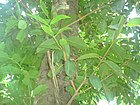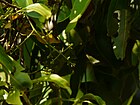Note: This is a project under development. The articles on this wiki are just being initiated and broadly incomplete. You can Help creating new pages.
Syzygium cuminii
Jambolan is a fast-growing, attractive, compact, evergreen shrub or tree with a dense, frondose crown. It usually grows 10 - 15 metres tall, but can reach a height of up to 35 metres. The straight bole is short, stout, and low branched, usually around 40 - 100cm in diameter.
Contents
[hide]- 1 Uses
- 2 Parts Used
- 3 Chemical Composition
- 4 Common names
- 5 Properties
- 6 Habit
- 7 Identification
- 8 List of Ayurvedic medicine in which the herb is used
- 9 Where to get the saplings
- 10 Mode of Propagation
- 11 How to plant/cultivate
- 12 Commonly seen growing in areas
- 13 Photo Gallery
- 14 References
- 15 External Links
Uses
Diabetes, Dysentery, Hyperglycaemia, Glycosuria, Wounds, Irregular menstruation, Diarrhoea, Dysentery, Mouth ulcers.[1]
Parts Used
Chemical Composition
It contains antianaemic, gingivititis, antidiarrhieal, antipyretic, antibacterial, antineoplastic, antiinflammatory, hypoglycemic, gastroprotective and hypolipidemic activities of phytochemicals.[2]
Common names
| Language | Common name |
|---|---|
| Kannada | |
| Hindi | |
| Malayalam | |
| Tamil | |
| Telugu | |
| Marathi | |
| Gujarathi | |
| Punjabi | |
| Kashmiri | |
| Sanskrit | |
| English |
Properties
Reference: Dravya - Substance, Rasa - Taste, Guna - Qualities, Veerya - Potency, Vipaka - Post-digesion effect, Karma - Pharmacological activity, Prabhava - Therepeutics.
Dravya
Rasa
Guna
Veerya
Vipaka
Karma
Prabhava
Habit
Identification
Leaf
| Kind | Shape | Feature |
|---|---|---|
Flower
| Type | Size | Color and composition | Stamen | More information |
|---|---|---|---|---|
| {{{5}}} |
Fruit
| Type | Size | Mass | Appearance | Seeds | More information |
|---|---|---|---|---|---|
Other features
List of Ayurvedic medicine in which the herb is used
Where to get the saplings
Mode of Propagation
Air layering, Seeds, Grafting.
How to plant/cultivate
A plant of the tropics and subtropics, where it is found at elevations up to 2,000 metres. It grows best in areas where annual daytime temperatures are within the range 20 - 32°c, but can tolerate 12 - 48°c. Mature growth can be killed by temperatures of -2°c or lower, whilst young growth is killed at -1°c.[4]
Commonly seen growing in areas
[[:Category:Herbs that are commonly seen in the region of |]], [[:Category:Herbs that are commonly seen in the region of |]], [[:Category:Herbs that are commonly seen in the region of |]], [[:Category:Herbs that are commonly seen in the region of |]], [[:Category:Herbs that are commonly seen in the region of |]].
Photo Gallery
References
- Jump up ↑ Indian Medicinal Plants by C.P.Khare
- Jump up ↑ Chemical constituents
- Jump up ↑ [Morphology]
- Jump up ↑ Cultivation details
External Links
- Ayurvedic Herbs known to be helpful to treat Diabetes
- Ayurvedic Herbs known to be helpful to treat Dysentery
- Ayurvedic Herbs known to be helpful to treat Hyperglycaemia
- Ayurvedic Herbs known to be helpful to treat Glycosuria
- Ayurvedic Herbs known to be helpful to treat Wounds
- Ayurvedic Herbs known to be helpful to treat Irregular menstruation
- Ayurvedic Herbs known to be helpful to treat Diarrhoea
- Ayurvedic Herbs known to be helpful to treat Mouth ulcers
- Herbs with Fruits used in medicine
- Herbs with Branchs used in medicine
- Herbs with Bark used in medicine
- Habit - Evergreen shrub
- Index of Plants which can be propagated by Air layering
- Index of Plants which can be propagated by Seeds
- Index of Plants which can be propagated by Grafting
- Herbs that are commonly seen in the region of
- Herbs






